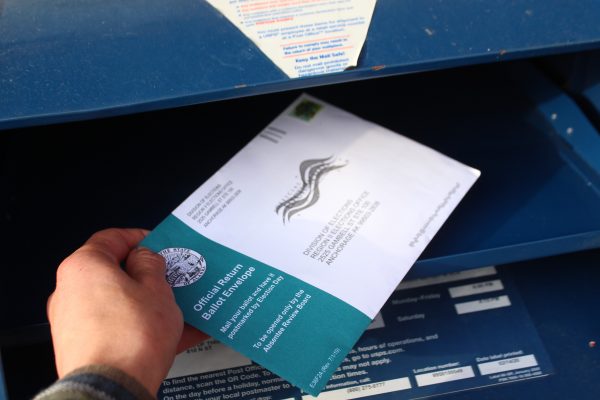
Early voting started Monday in Alaska for the general election, and more than 35,000 Alaskans have already returned their absentee ballots.
For those who haven’t cast their ballots yet, here’s a quick guide on how to vote this year:
How many different ways can Alaskans vote?
There are three main ways: absentee, early in person, and in person on Election Day, which is Tuesday, Nov. 3.
Is it too late to apply to vote absentee?
No, but time is running out.
The deadline to request an absentee ballot is this Saturday, Oct. 24. The state Division of Elections must receive the application by then, so Alaskans who want to apply by mail should send in their applications as soon as possible. Alaskans with a driver’s license or state-issued ID can apply online through Saturday.
With COVID-19, how many more people are planning to vote absentee?
Many more than in any previous year. There have been 120,419 applications so far. That’s more than a third of the total number of votes cast in Alaska in the last presidential election. And the absentee ballots already returned equal roughly 10% of the 2016 total statewide vote.
Is there anything different about the absentee ballots?
The ballot itself is identical to the one used by Alaskans casting their vote in person.
But, absentee voters must sign the envelope provided with their ballots and provide a personal identifier — either their voter number, driver’s license number, date of birth or the last four digits of their Social Security number.
Do absentee voters need a witness?
No, not this year. A judge ruled that a witness is not required due to concerns about the pandemic. The Alaska Supreme Court allowed that decision to stand. But voters must still sign and provide the personal identifier on the envelope.
Will voters have a chance to correct a mistake if they fail to sign and provide an identifier on their envelope?
No. While municipal elections in Anchorage and Juneau allow voters to fix mistakes, state law doesn’t provide for that. An Anchorage Superior Court judge recently rejected a request that the state quickly notify voters if they fail to sign or provide identifying information on their mailed ballots, saying that wouldn’t follow state law.
Voters will be notified if their absentee ballot was rejected within 60 days of the certification of elections results. Since the target for certifying the results is Nov. 25, this will be in late January.
What’s the deadline for mailing an absentee ballot?
The envelope must be postmarked by Election Day, Nov. 3. Voters can ask at their post office for their envelopes to be postmarked in person. If they don’t do this, the U.S. Postal Service sends mail across Alaska to Anchorage to be postmarked. So on Election Day, or the day before it, voters should ask a postal clerk to postmark the envelope.
And what’s different about early voting?
It’s a lot like voting on Election Day, but done in the 15 days before the election. A trained election worker at an early voting location has a voter sign their name and provides a ballot.
When and where can Alaskans do early voting?
There’s a list of locations on the Division of Elections website, which also includes the days and times at each location.
How is COVID-19 changing the election?
There will be more safety precautions at polling locations, including keeping voting booths further apart for social distancing. Since more voters plan to vote absentee, it will be longer before the results are known.
The Division of Elections had problems finding poll workers in seven rural precincts in the primary election. Has that been fixed for the general election?
Division Director Gail Fenumiai said there is at least one election worker for each precinct. But the state is still looking for more workers in northern, western and southwestern Alaska. If there are shortages on Election Day, voters will be asked to fill out absentee ballots in person , so their votes will still count. The division also has worked to fix a problem that prevented many voters in the Western Alaska village of Mertarvik from voting in the primary. They will vote using absentee ballots on Election Day.
Is there assistance for voters in languages other than English?
Yes. There is assistance available in several Alaska Native languages, as well as in Spanish and Filipino. The Division of Elections translated election materials on its website and offers on-call interpreters on Election Day.
How can Alaskans learn more about the candidates and ballot measures this year?
Alaska Public Media is hosting debates between the U.S. House candidates on Thursday and the U.S. Senate candidates on Friday. In addition, Alaska Public Media and KTOO hosted debates on eight of the 39 contested legislative races, which are available online.
Alaska Public Media also recently published articles about Ballot Measure 1 and Ballot Measure 2. Individual public media news organizations have been covering races in their districts. KTOO will have an election guide for Juneau’s legislative candidates. The Anchorage Daily News published an election guide that covers the congressional candidates and the legislative candidates in Anchorage and the Matanuska-Susitna and Kenai Peninsula Boroughs.
Want to learn more about voting in your Alaska community?
The Division of Elections website has more detailed information about how to vote. You can also email questions or concerns about the 2020 Election to news@alaskapublic.org.
Andrew Kitchenman is the state government and politics reporter for Alaska Public Media and KTOO in Juneau. Reach him at akitchenman@alaskapublic.org.




